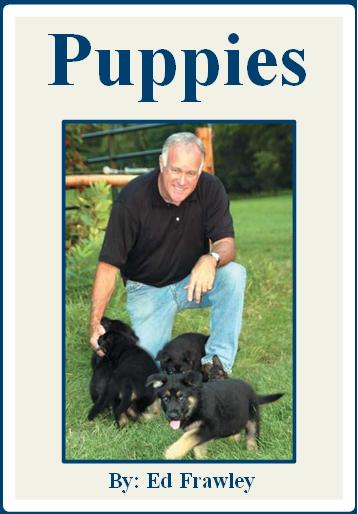Puppies
By: Ed Frawley
Pack Structure
Dogs are pack animals, just like wolves are pack animals. They are predators. Horse and cows on
the other hand are herd animals and as such they are prey animals.
Predators live by one set of genetic rules, prey animals live by a different set of genetic rules. Pack animals live in family packs which have a pack leader and lower ranking pack members.
Dog packs, like wolf packs, are not a democracy. A pack is organized in a hierarchy of rank. Simply
put this means every member of the pack knows exactly what its rank is within the family pack. Pack animals genetical y understand this concept. This concept is the reason people have dog fights when they add a new dog to a home that already has dogs. Everyone has to re-establish the new pecking order when a new pack member comes on board.
The Beginning of Pack Structure
When a puppy is raised with litter mates they begin to establish their family pack at about 4 ½ weeks of age. They start by playing with one another.
They bite and push each other around. Those pups that bite the hardest and push the most become the higher ranking pack members of the litter.
With that said there is no question that the mother is the pack leader. A good mother wil exert her leadership by warning puppies to stay away from her food bowl when she is eating. She protects her litter which demonstrates leadership and she also controls the litter in subtle ways that establish her as the pack leader.
What is a Pack Leader?
When people get puppies they need to establish themselves as the new pack leader. To do this correctly they should first understand exactly what a pack leader is.
Pack leaders are aloof, they are calm and they are self confident. A pack leader is fair in how he lives
with pack members and while he is a dictator, he is a fair dictator who enforces a wel defined set of rules that members know, understand and are expected to live by.
What a pack leader is not is a dictator who looses his temper, bul ies pack members into compliance, and does not act in a fair manner in regard to the lives of pack members.
For example, the leader always eats first. Lower ranking members don’t get the choice food. But when the leader is finished and he turns the food over to other pack members, he does not come back and drive them away from the food.
People who put food down and then take it away or push the dogs away from the food bowl are bul ies. This is how their dogs view them too. This is not practicing fair leadership principles.
The correct way is to make the dog do something (i.e. sit) before the food is put down. But once its
down they leave it alone until its time to pick it up. We leave food down for 15 minutes and then pick it up, even if the dog has not eaten it al .
It’s easy to bul y your way into a leadership position. People (mostly men) do this al the time. The problem is that the bul y destroys their relationship with their dogs.
I want my pack members to trust me, feel relaxed around me and be comfortable in my presence.
The only way this can happen is if they know the rules and anticipate our expectations. When that happens they know they wil be treated fairly. They also know that if they ignore the rules they
wil suffer the consequences.
This leadership relationship is a learned endeavor.
It’s learned through the day to day experiences of living with an owner who establishes and enforces rules. It’s also learned through formal obedience training. But with this said I tel people that hundreds of thousands of dogs go through obedience classes in this country every year. The vast majority of
dominant dogs come out of these classes just as dominant as when they went in. That’s because
the owners were not trained in pack structure.
When puppies grow up and become dominant, aggressive dogs they always live with people who do not establish the correct family pack structure.

